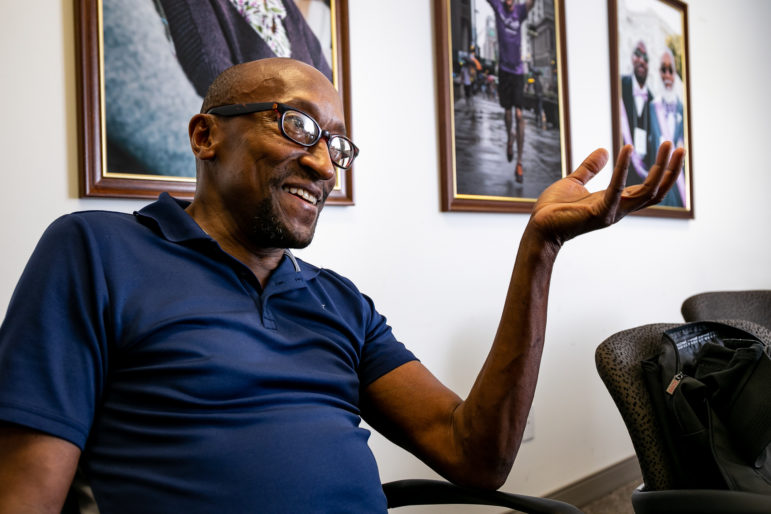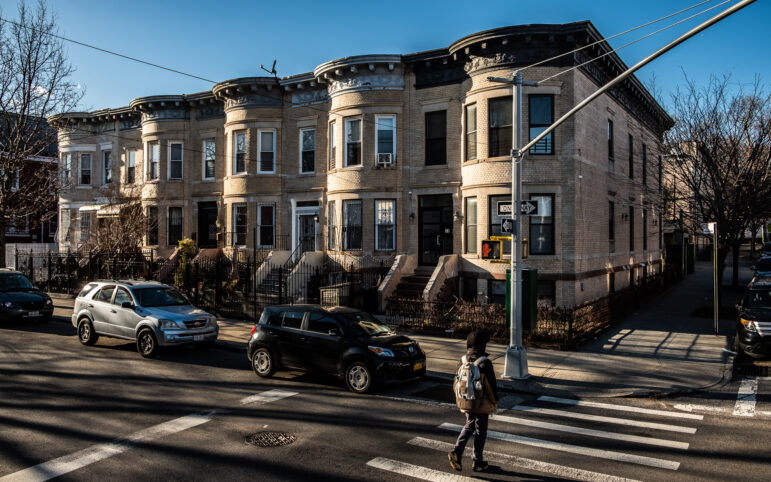
Adi Talwar
Ed Smith (69) cried when he first learnt of his Alzheimer’s diagnosis five years ago. Since then, he has embraced art as a way to fight off the effects of the disease.
Five years ago, Ed Smith started forgetting things he used to take for granted. Daily life got more complicated and confusing.
It was a scary change for Smith, who had graduated from the University of California, Berkeley with a degree in architecture and environmental design, worked as a proofreader for the Village Voice and traveled around Africa and the West Indies as a staff reporter for Black Enterprise and Essence.
Smith had also cared for his mother after she was diagnosed with Alzheimer’s. That experience gave him a sense that he too may have developed the disease and, after trying to ignore instances of memory loss and confusion, he finally visited a hospital. There, tests confirmed that he had Alzheimer’s.
“When I found out, I cried,” he says. “But then I said, ‘What am I going to do about this?'”
Smith, who says he “grew up in museums” and attended the High School of Music & Art, stayed active. He eventually connected with the Alzheimer’s Association New York City Chapter and began to help staff plan a series of art workshops and creative endeavors for people with early-stage Alzheimer’s.
The activities reflect a growing emphasis on the arts as a vital vehicle for stimulating brain activity, providing therapeutic services and fostering connections among people with Alzheimer’s and their care partners.
Large cultural institutions, led by the Museum of Modern Art, have also embraced arts programs for people with Alzheimer’s and other forms of dementia. Throughout the city, museums, gardens and performance spaces have tailored interactive events for people with the disease, their loved ones and their caregivers.
Smith says the Alzheimer’s Association programs, including Latin dance classes and creative writing sessions, enable him to interact with a diverse group of New Yorkers, develop new skills and tap into long-dormant feelings, emotions and memories.
“Something happened last week when I was working on a collage,” Smith says. “I was 10 years old, 12 years old, like I was in art class again. I had this response to color and shapes and as I was reaching for something, my whole body calmed down and it was amazing. It’s been a long time since I’ve felt that.”
In the absence of a cure
In New York State, roughly 390,000 individuals have Alzheimer’s Disease, the state Department of Health reports. As the population ages, DOH estimates that the number will increase to 460,000 by 2025.
The disease is the ninth-leading cause of death in New York City, according to the 2016 Summary of Vital Statistics, the most recent report available on the city’s website. That year, more than 20,500 died of Alzheimer’s.
Alzheimer’s gradually advances through the brain as amyloid plaques invade the space between nerve cells and block their connections. At the same time, tangled protein fibers called tau build up inside the nerve cells. Early signs of Alzheimer’s include memory loss and personality changes, which worsen as the disease progresses through the brain, affecting different regions in a sequence. Eventually, Alzheimer’s results in the inability to perform activities of daily living, including continence and the ability to feed oneself.
Though there is no cure, experts and practitioners have identified art engagement as a way to potentially slow the progress of Alzheimer’s by stimulating the brain and preserving its plasticity, especially in regions, like the parietal lobe, that tend to be affected later in the course of the disease, researchers say.
Creative pursuits also improve quality of life and prevent social isolation for people with Alzheimer’s as well as their loved ones, says Nicole Manza, coordinator for the Early Stage Social Engagement Program, in which Smith participates.
“You see couples [where one partner has Alzheimer’s] withdraw from social activities with the couples they used to have relationships with. It can be isolating,” Manza said. “But [the programs] allow them to make new relationships among spouses and go out as group.”
The Alzheimer’s Association receives funding from the state Department of Health, which enables them to offer the arts activities and other programs for free. Agency staff partner with community-based organizations and conduct workshops in various neighborhoods citywide.
“Our goal is to reach every New Yorker in need of services, especially those living in typically underserved, low-income communities,” the organization said in a statement.
A 2014 report in the Journal of Alzheimer’s Disease notes that “case studies and several small trials suggest that art therapy engages attention, provides pleasure, and improves neuropsychiatric symptoms, social behavior and self-esteem.” Another 2014 article in the Journal of Alzheimer’s Disease and Other Dementia examined the influence of museum-based programs on individuals with Alzheimer’s and found improvements in “cognitive stimulation, social connections and self-esteem.”
Such research, along with the qualitative experience described by patients, therapists, instructors and care-partners, prompted the Manhattan-based organization CaringKind to begin training cultural institutions to host programs for individuals and families affected by dementia.
“With a disease like Alzheimer’s, there is really no medical answer. Treatment is moderately effective for a limited time,” says CaringKind President and CEO Jed Levine. “The real treatment is good care [and] part of that is providing opportunities to reconnect, engage and experience the pleasure, beauty and joy of cultural arts.”
CaringKind already provided information and support for individuals and families affected by Alzheimer’s and dementia when it decided to extend that support to arts institutions through the Connect2Culture initiative. Connect2Culture trains institutions on how to serve people with Alzheimer’s and has partnered with about 20 different sites, including the Met, the Brooklyn Museum and the Jewish Museum to teach best practices for hosting people with Alzheimer’s and their care partners.
“It’s important to see through the eyes of the person with dementia and the caregiver’s eyes as well,” says Connect2Culture Manager Meredith Wong. “The things we take for granted are more difficult for people with Alzheimer’s.”
Too much stimulation—often the case in crowded and noisy museum galleries—can distract and scare people with dementia and make it hard for them to focus, Wong says.
“We want to control the environment from the time they walk into the cultural institutions so we work with educators and with front-of-house staff like security to make sure it is a supportive and seamless experience,” Wong said. “I have had security guards come up to me and say, ‘How can I learn more?'”
Wong says she encourages museums to open the trainings to all staff members, from administrators and instructors to custodians and clerks. Each person plays a role in fostering a calm and sensitive environment for visitors with Alzheimer’s and often, she says, they have loved ones with the disease.
Most of the institutions allow individuals with Alzheimer’s and their care-partners to access the programs for free, but the price of participation varies by location, Wong said. She said she informs institutions that free admission has become an expectation among many program participants.
Jessica Gonzalez is one of the New Yorkers who has benefited from the museum-based programs, which enable her to connect with her mother who has Alzheimer’s. Gonzalez helps her father care for her mother, 72, in the couple’s Brooklyn home. She says she began taking her mother to museum-based events to help give her father a break. As she accompanied her mother on more museum trips, she developed a network of friends who shared her experience, she says.
“The family members created a quasi-support group because we see each other every few months and we form bonds and connections with each other,” says Gonzalez, who now works for CaringKind as manager of constituent events.
At the same time, the citywide programs helped her mother develop her own relationships with other participants, though it took time.
“It wasn’t until three months of doing this weekly, we asked her and she said ‘I saw my friend,'” Gonzalez says. “She knew she had someone she connected with. Now [my mother], this woman and this other guy are sassy trouble. They love to dance and they love to sing. They sass the museum staff.”
A broader impact
MoMA was the first New York City museum to champion special programs for people with Alzheimer’s, Levine says. The Meet Me at MoMA initiative, a series of free events that launched in 2006, was inspired by a mission to create meaningful experiences for people with the disease to share with their family members, says Francesca Rosenberg, MoMA’s director of community access and school programs.
“Art is the perfect tool for this because it doesn’t require memory,” Rosenberg says. “What they’re looking at and thinking about is right in front of them and so they’re able to respond to it.”
MoMA staff also work with people with Alzheimer’s and dementia inside supportive housing sites for seniors, nursing homes and senior centers in neighborhoods with a higher poverty rate than the city average, she says. Locations include the Casa Boricua Senior Center near Crotona Park in the Bronx, the Amsterdam Adult Day Health Care in Harlem and the George Rosenfeld Center for Recovery on Ward’s Island.
The relationships that develop during the outings and off-site activities persist, even after the person with Alzheimer’s dies, she says. One former care-partner began working as a MoMA volunteer while others invite the museum staff to their loved ones’ funerals, she says.
Inside the conference room where Smith sat and discussed his life before and after his diagnosis, Amanda Clears prepared to lead an arts session that incorporated pastels and creative writing for people with early stage Alzheimer’s and varying levels of artistic experience.
As the artists wrote or illustrated, they considered prompts such as, “If your disease was sitting across from you what would it look like?” and “Create an image in response to your disease.” She later encouraged participants to share their art during a “processing” period.
Clears has an art therapy masters from Pratt and works at the Hebrew Home at Riverdale. She says she was inspired to work with older adults with dementia after her grandfather developed Lewy body dementia and Parkinson’s disease about 10 years ago.
“To watch a brilliant man, a graduate of Harvard Law and Wharton School of Business, become withdrawn, aloof, distant and incapable of taking care of himself was heartbreaking,” she says.
Though communication became impossible, Clears says the strong bond she shared with her grandfather “transformed into something more and more spiritual.”
After he died, Clears says she committed to improving the quality of life of others who contend with Alzheimer’s and dementia.
“I seek to give them the space to rediscover their creative potential and autonomy, focus on the soul of the individual that remains intact as the disease progresses and ultimately provide them with a better quality of life,” she says.
To Smith, that space is crucial for delaying the inevitable progress of the disease and for savoring the life he has left.
“Sitting around is the worst thing I can do. Anything that keeps my mind active is good,” he says. “When I go, I’m gone. But in the meantime, I’m kicking and screaming.”
City Limits’ reporting on the intersection of art and policy is supported by the Laurie M. Tisch Illumination Fund. City Limits is solely responsible for all content.









2 thoughts on “City Institutions Battle Alzheimer’s With Art”
Pingback: Harlem Resident Talks Living With Alzheimer's
As both a Licensed Creative Arts Therapist and Licensed Marriage and Family Therapist, I have a great deal of experience with the Alzheimer’s population. My creativity helped me work and enjoy time with my mother and brother who I lost to this horrible disease. I watched how tge pleasure and simple knowledge of color and form, deteriorated over time. Art connected me to my family in a very unique way. People at the homes each stayed in, as the time overlapped each other’s lives, would marval and smile, at the pure joy of our experiences.
As their thoughts, knowledge, activities of daily living congealed so did the fragments of “art” they produced.
I see people in my private practice, who are caregivers or grieve when their caring role shrinks to nothing.
Both art and music have an important place in my heart for the memory impaired.
I recently dedicated the song I wrote to honor the unspoken voice of Alzheimer’s Disease.